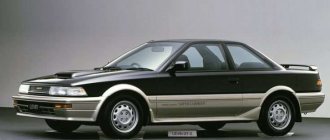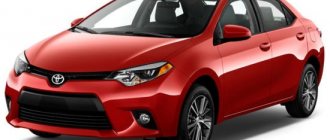Toyota Ceres, along with Mark 2, Sprinter Marino and some other models, is considered a little legend of a major manufacturer. It was produced together with the last one (Sprinter Marino) and was almost identical to it, with the exception of some body features. This Toyota model is another modification of the Corolla, namely its fifth generation. One of the few produced in a hardtop body, it was very popular both in the domestic market of the country and abroad. And this popularity continues to this day.
Ceres/Marino modifications
The Ceres/Marino car lines had the same power units. There was only front-wheel drive. The cars were equipped with manual or automatic transmissions and three types of A-series engines. These were:
- four-cylinder DOHC – 4A-GE 20V 1.6 l;
- four-cylinder 16-valve DOHC – 4A-FE 1.6 l;
- and a four-cylinder 16-valve DOHC injector – 5A-FE 1.5 l.
Ceres 1992, 1st generation, E100
According to the types of units installed, there were the following basic modifications of Ceres/Marino.
G type
The maximum level package, which came with a 1.6-liter twenty-valve naturally aspirated engine 4A-GE (160 hp at 7400 rpm; 162 Nm at 5200 rpm), equipped with a VVT system.
In 1995, Ceres/Marino faced major design changes.
Two engines, gearboxes, suspension elements and much more were modified. The F-type began to be equipped with the same 5A-FE unit, but with less power, but more torque (100 hp at 5600 rpm and 142 Nm at 4400 rpm). The G-type was equipped with a modified version of the 4A-GE 20V engine (165 hp at 7800 rpm and 162 Nm at 5600 rpm).
In 1997, the latest improvements were made to the Ceres/Marino design. Finally, it was time to modify the mid-level configuration and its engine. ICE 4A-FE, which, like 5A-FE, has become slightly weaker in power and speed (110 hp at 5800 rpm and 149 Nm at 4600 rpm).
From mid-1997, serial production of the much-loved Ceres/Marino car began to gradually wind down and a year later it was finally discontinued.
Sprinter Marino restyling 1994
Restyling of Toyota Ceres
At the end of spring 1994, Ceres cars underwent modernization, which slightly changed the outline of the front bumper and radiator grille. Sedans also received new taillights, but the body panels and trim remained unchanged. Aluminum wheels changed only in the summer of 1997. At the same time, a 6-speed manual transmission began to be used (for the G-Type model).
In 1994, Ceres underwent modernization.
4A-FE (4A-GE)
In parallel with the S-series power plants, A-motors were produced, the most popular among which was the small-volume 4A unit, produced in various modifications.
As the 4A was improved, which initially was nothing special and was the most ordinary single-shaft low-power carburetor engine, it received a fuel injection system in the 4A-FE version for Ceres/Marino.
| 4A-FE | |
| Volume, cm3 | 1587 |
| Power, hp | 99-116 |
| Consumption, l/100 km | 3.9-10.9 |
| Ø cylinder, mm | 81 |
| SS | 09.05.2011 |
| HP, mm | 77-78 |
| Models | Avensis; Carina; Carina E; Celica; Corolla; Corolla Ceres; Corolla FX; Corolla Levin; Corolla Spacio; Corona; Corona Premium; Sprinter; Sprinter Carib; Sprinter Marino; Sprinter Trueno |
| Resource, thousand km | 300+ |
4A-GE - a traditional high-power power unit, developed in collaboration between Toyota and Yamaha, and dating back to the American Formula Atlantic, was equipped with a 20-valve cylinder head and MPFI injection.
| 4A-GE | |
| Volume, cm3 | 1587 |
| Power, hp | 112-165 |
| Consumption, l/100 km | 4.7-9.4 |
| Ø cylinder, mm | 81 |
| SS | 09.05.2011 |
| HP, mm | 77 |
| Models | Carina; Corolla; Corolla Ceres; Corolla FX; Corolla Levin; Sprinter; Sprinter Carib; Sprinter Marino; Sprinter Trueno |
| Resource, thousand km | 300+ |
Under the 4A-GE head were installed: camshafts with a high cam profile, characterized by more rigid operation due to the increased height; modified intake and new piston group.
Blackhead 4A-GE under the hood of a 1993 Ceres
How much does a Toyota Corolla Ceres cost today?
Since the production of cars ended in 1998, these cars are currently at least 20 years old, or even more. Therefore, the cost fully depends on the condition, the presence of additional modern “goodies”, in particular, tuning, etc. As a rule, the price varies between 130-160 thousand rubles. For this money you can buy a good car with minimal defects.
If the car costs less than 100,000 rubles, it means it has been damaged or needs major repairs. For 250,000 rubles. you can buy a tuned car, stuffed with various additional elements. For such a car this amount is more than acceptable.
The Toyota Corolla Ceres is an ideal option for those who want to buy an inexpensive, high-quality used car at a below-average price. Any car owner will confirm that this is the car that will never let you down.
5A-FE
An analogue of the 4A power units is the 5A engine with a volume of 1500 cc. cm received a cylinder diameter reduced to 78.7 mm, otherwise it was still the same 4A-FE, with all its advantages and characteristic malfunctions.
| 5A-FE | |
| Volume, cm3 | 1498 |
| Power, hp | 94-105 |
| Consumption, l/100 km | 3.9-8.2 |
| Ø cylinder, mm | 78.7-79 |
| SS | 09.08.2010 |
| HP, mm | 77 |
| Models | Carina; Corolla; Corolla Ceres; Corolla FX; Corolla Levin; Sprinter; Sprinter Carib; Sprinter Marino; Sprinter Trueno |
| Resource, thousand km | 300+ |
5A-FE is the most common civilian unit; no sports versions have been developed based on it. Production of the 1987 engine was completed in 2006, but even today some Chinese cars are equipped with it.
5A-FE in the engine compartment of Sprinter Marino
Owner reviews
On one of the websites, Toyota Corolla Ceres was given 8 points out of 10 possible. This is one of the most popular cars in the world of the 1990s, which does not lose popularity today, despite the fact that production ended 20 years ago. These “babies” still delight their owners with unsurpassed Japanese quality and comfort.
The Toyota Ceres car has a lot of advantages. And its shortcomings are minor. This is a nimble, reliable and economical car that has average fuel consumption and sufficient engine capacity. The machine is inexpensive to maintain, but some parts can be difficult to find and are relatively expensive. Also among the minuses are the small ground clearance and insufficient space in the cabin. Although some other car owners write that there is quite enough space. As they say, to each his own.
It is important to emphasize that the quality of the car from the Japanese manufacturer is truly at the highest level. For many, it did not break at all for several years. So this C-class goddess deserves attention.
Problems with Corolla Ceres/Sprinter Marino engines
The reasons for vibration and higher fuel consumption on 4A-FE/GE in Ceres/Marino are most likely a faulty oxygen sensor or dirty injectors. When black exhaust appears, the first thing to check is the DBP sensor.
RPM problems on these powertrains are most often related to the idle air valve or throttle body. The reasons for the freezing speed may also be in the internal combustion engine temperature sensor or in the crankcase ventilation system.
The appearance of “oil guzzler” on 4A-FE/GE is a common occurrence and the manufacturer allows it up to a liter per thousand kilometers. If this threshold is exceeded, then only replacing the valve seals will help.
The cause of knocking in a well-worn 4A-FE/GE engine is usually the piston pins. Adjustment of valve clearances on these units should be carried out once every 100 thousand km.
Engine 4A-FE in the engine compartment Ceres
In general, all the troubles associated with 4A-FE/GE units usually occur not because of mistakes by engineers in their design, but because of high mileage. The service life of any good 4A series engine is about 300 thousand km, then problems begin.
It is worth noting that all of the above malfunctions are also typical for engines of the 5A line - they were developed on the basis of 4A engines. Thus, the design of the 5A-FE power unit is completely identical to the 4A-FE, as are the faults inherent in this engine.
Description of Toyota Corolla Ceres
The Ceres car is distinguished by neat body lines, on which the number of protruding elements is minimized. The first photographs, officially shown by Toyota a year before the start of deliveries, ensured the popularity of the model in Japan.
Toyota Ceres were painted with standard enamels or paints with the addition of metal powder (5 colors were available). Bumpers, door handles and mirror housings were painted by default.
What it looks like (photo)
The photo shows a Toyota Ceres, which was equipped with narrow head optics with a small radiator grille. Additional air intakes were located in the massive bumper. The rear doors were designed to overlap the wing, making it easier to board and disembark passengers. There was a plastic protective trim on the side panels of the doors. The narrow aft lighting equipment was separated by a black panel mounted on the trunk lid. The model designation was printed in large letters on the bumper below the luggage compartment opening.
Toyota Ceres was equipped with narrow head optics.
Dimensions and weight
Main dimensions and weight of the Ceres car:
- body length – 4365 mm;
- wheelbase – 2465 mm;
- track – 1460 and 1450 mm (front and rear);
- width – 1695 mm;
- height – 1315 mm;
- interior length – 1795 mm;
- ground clearance - at least 140 mm;
- curb weight – from 1010 to 1120 kg.
Interior
Soft plastic and natural fabrics were used in the interior decoration (on expensive modifications, the chairs and door cards were covered with velor). The front seats with separate adjustments were equipped with headrests. Standard equipment included an analog instrument cluster with a tachometer. Illumination lamps were provided on the ceiling lining and rear pillar trims. The door cards had pockets for bottles. High-quality interior trim ensured reduced noise when driving.
The interior of the cabin is made of natural fabrics and plastic.









